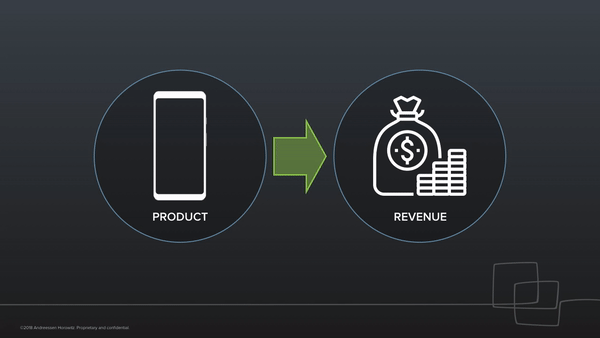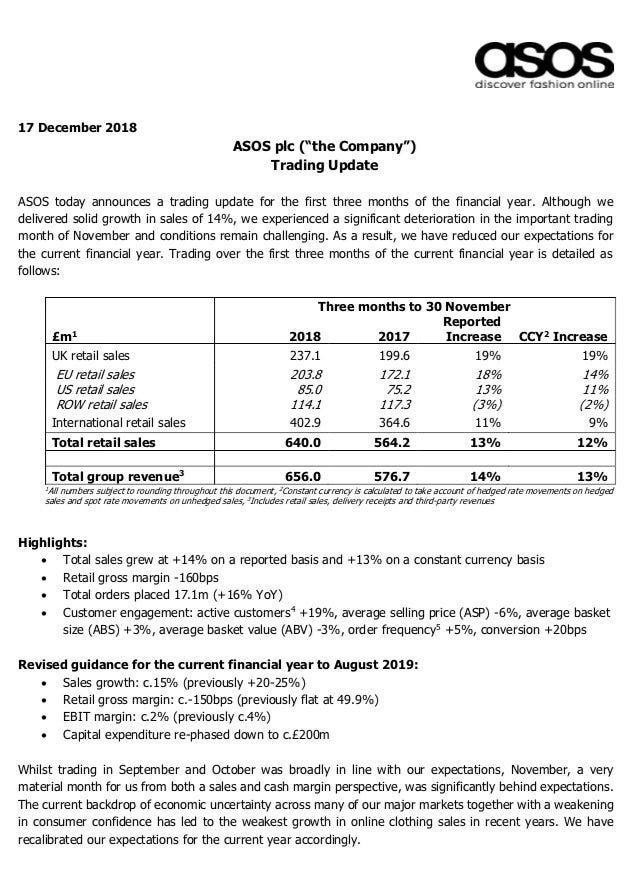Latest news about Bitcoin and all cryptocurrencies. Your daily crypto news habit.
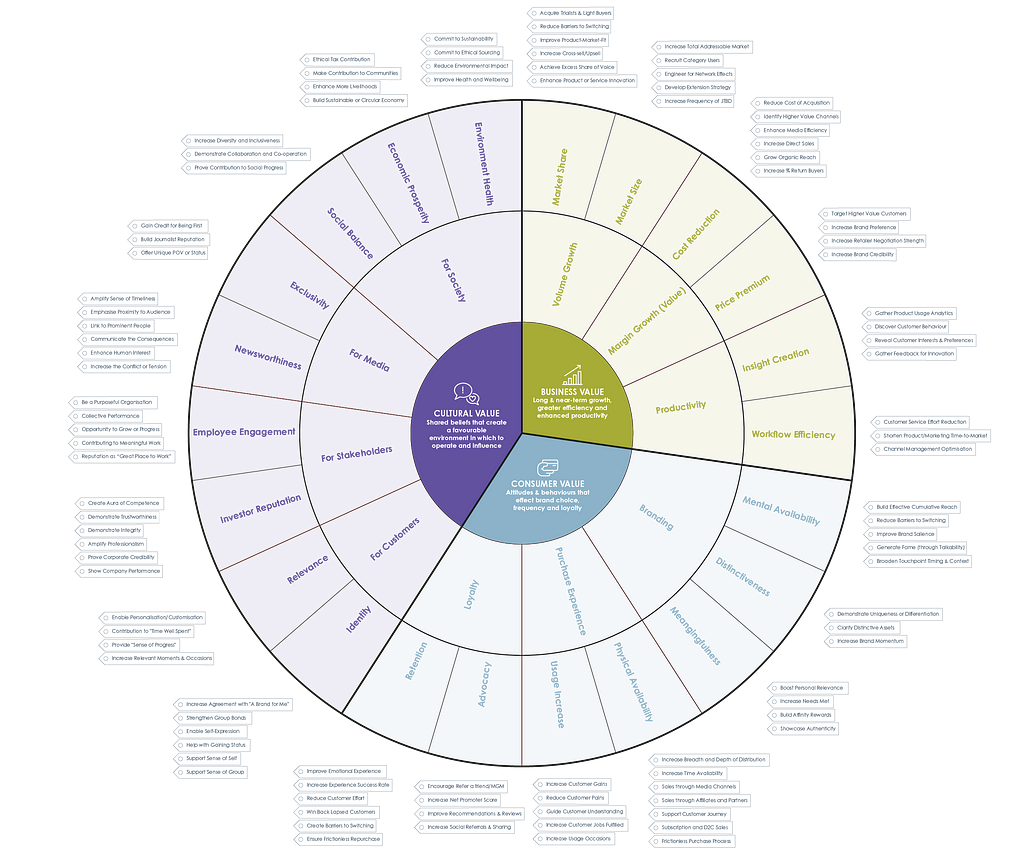 A Marketing Value Wheel with Drivers, Strategies and Value Creation Tactics to increase Business, Consumer and Cultural Value (download PDF Version)
A Marketing Value Wheel with Drivers, Strategies and Value Creation Tactics to increase Business, Consumer and Cultural Value (download PDF Version)
After “Strategy”, value is probably the most abused word in marketing.
A quick survey of agency, consultancy, studio and creative/strategy collectives’ websites will turn up multiple claims to “create value for clients and their customers”. Whether talking about campaigns, brand experiences or new products, the result of any initiative is usually “added”, “newly created”, “delivered” or “unlocked” value.
But what do we mean by “value”?
Is “value” in marketing a euphemism for something more difficult — for an outcome that we find hard to measure or pin down, for something that is different depending on where you sit in an organisation or department? To paraphase Montoya, we “keep using that word. I do not think it means what you think it means.”
Mariana Mazzucato’s superb “The Value of Everything” points out that value is often understood as anything that can fetch a price in the market; as a result, price determines value. And yet she also avoids trying to define “value”, instead asking what is value, why does it matter, and who creates it?
These questions inspired me to look again at how we can communicate the value created by marketing, as well as how we measure and increase it.
Marketing’s 3 Types of Value: Business, Consumer and Cultural
“There is only one definition of business purpose: to create a customer….It is the customer who determines what a business is. It is the customer alone whose willingness to pay for a good or for a service converts economic resources into wealth, things into goods.”
At first glance Peter Drucker’s famous definition from Chapter 6 “What is a Business” in “Management: Tasks, Responsibilities, and Practices” sets up a noble contrast to the rapacious doctrine of Maximised Shareholder Value.
But this does not excuse business from the commercial imperative, for as Drucker continues:
“Profit is not the explanation, cause, or rationale of business behavior and business decisions, but rather the test of their validity. If archangels instead of businessmen sat in directors’ chairs, they would still have to be concerned with profitability, despite their total lack of personal interest in making profits.”
With Drucker’s words as a springboard I began reviewing books, case studies and ideas from colleagues and other strategists about marketing and value.
Marketing’s purpose is to create the right volume of customers willing to pay for a good or service in a way that will ensure the long-term profitability of the business. This is its vital contribution. In light of this purpose I would propose 3 types of value that enable marketing to have an effect on the success of a business, with their influence ranging from direct to in-direct:
BUSINESS VALUE: Long & near-term growth, greater efficiency and enhanced productivity
CONSUMER VALUE: Attitudes & behaviours that effect brand choice, frequency and loyalty
CULTURAL VALUE: Shared beliefs that create a favourable environment in which to operate and influence
But how can marketing create these types of value? What levers can we pull that ladder up to a positive impact on the health of our companies or clients?
As marketers in an ever more pressured environment we need to identify, prioritise and accelerate actions marketing can take to increase value. To do this we need to focus on the strategies and tactics that have the greatest influence on value and identify opportunities to improve delivery.
Based on the various books and research papers I put together the Marketing Value Wheel framework below:
 A Marketing Value Wheel with Drivers, Strategies and Value Creation Tactics to increase Business, Consumer and Cultural Value (download PDF Version)
A Marketing Value Wheel with Drivers, Strategies and Value Creation Tactics to increase Business, Consumer and Cultural Value (download PDF Version)
The central ring of the Marketing Value Wheel is made up of the top cited Drivers of Business and Consumer Value such as Volume Growth, Margin Growth (Value), Productivity, Branding, Purchase Experience, and Loyalty as well as 4 of the publics* that marketing influences to create Cultural Value.
The outer ring consists of Strategies that have been identified in IPA Effectiveness Awards papers and other effectiveness research as having a strong impact on these Value Drivers. Finally, listed outside the wheel are just some of the Value Creation Tactics that have been successfully shown to activate the Strategies in case studies and award papers on WARC.
Value > Drivers > Strategies > Tactics
The Marketing Value Wheel can be used in different ways:
To follow a centre-out approach, looking at each value driver chain and focus on identifying opportunities in key areas.
To follow an outside-in approach, evaluating whether current actions fully support improving value overall or in specific areas.
To map existing projects against the value wheel to determine where there are opportunity or overlap areas and to determine which projects and investments best support value delivery.
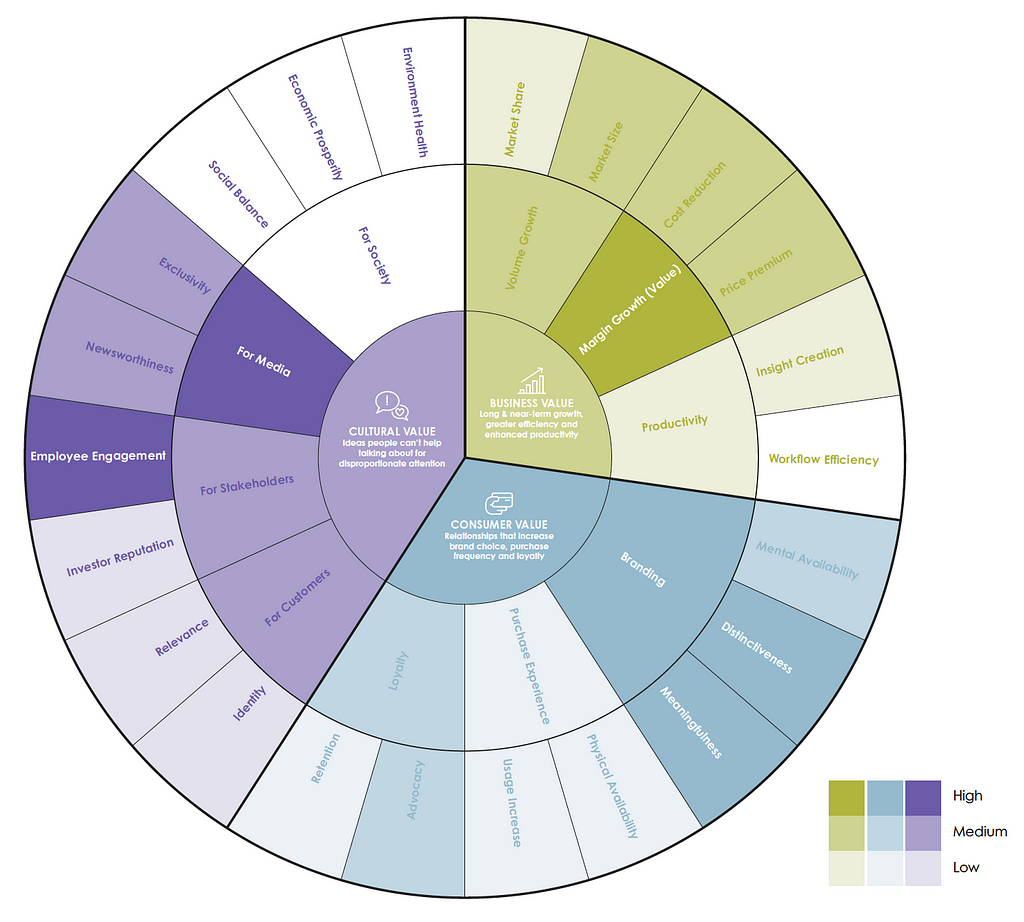 Using the Marketing Value Wheel to identify where the value lies in a project using a “heat map”
Using the Marketing Value Wheel to identify where the value lies in a project using a “heat map”
We’ve had the best successes using the Marketing Value Wheel with cross discipline or cross hierarchy teams, helping marketing and the C-suite align goals and see the impact of their colleagues’ priorities. It can help bridge the gap between teams at the coal-face for whom value is often shipping something — whether it’s something that makes the customer more successful, new features or products, a media buy, or creative seen by a potential customer — and “the metrics most executives use to measure business value [that] are so high-level that understanding the correlation between them and what the teams are doing is hazy.”
The “heat map” version above is one example where we used the wheel in a workshop to challenge perceptions that a digital sponsorship function had no business value and existed “for its own sake”. It helped gain exec support for the function, however, at the same time it helped transform the sponsorship strategies and tactics so that they were more in keeping with what the business needed it to deliver.
In addition, by using the “centre-out approach”, looking at each value driver chain and focusing on identifying opportunities in key areas, the wheel has also been useful in generating initiatives to address business challenges or potential areas for innovation. It can help with focusing on the potential high level drivers that can answer the business’ problem statements and then work through to tactical solutions like communications campaigns or product roadmap changes. This “Value First” exercise can be a useful “step back” or reframing when the marketing or product functions have become too focused on the operational day-to-day or too mired in “making things for the sake of making things”.
Connie Chan in her excellent piece on Outgrowing Advertising: Multimodal Business Models as a Product Strategy talks about “business models as a product strategy” and how “expanding sources of revenue pushes us to think beyond what we know, and creates the infrastructure that opens up new opportunities.” The Value Wheel is a simple tool that can help marketing take its place at the heart of this “flip” by aligning the connection between outputs, outcomes and the value impact they have on the business.
But where we have found the wheel most useful is in helping marketing break down self-imposed language barriers.
Language barriers to the boardroom
Since 2013's The Long & the Short of It, Binet & Field have demonstrated the increased tendancy of marketing to focus on short-term activation over long-term brand building. Short-term activation generates sales now, exploiting mental brand equity with tightly targeted, persuasive messages.
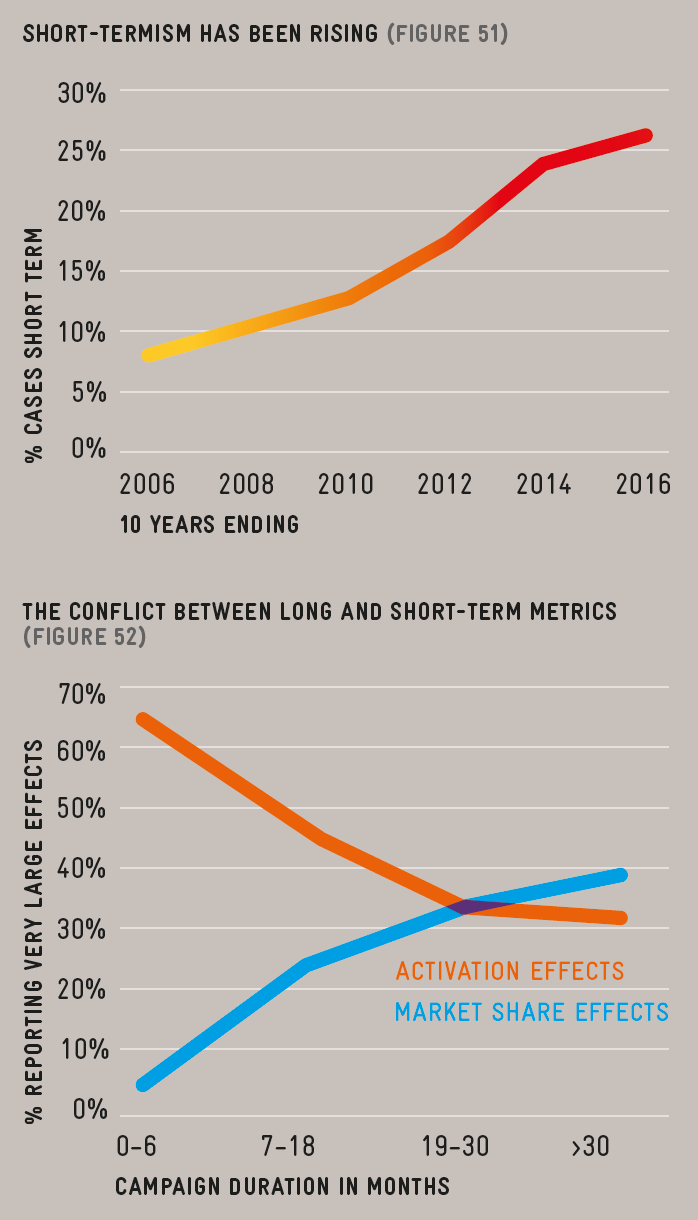 From Media in Focus: Marketing Effectiveness in a Digitas Era
From Media in Focus: Marketing Effectiveness in a Digitas Era
Surely focusing on sales driven results is a good thing and can only make us friends in the boardroom?
Unfortunately it has had two side effects. The first is the well-documented decline in real effectiveness, but the second reflects how our language as marketers influences our place in organisational culture.
The rise of short-term activation has been a reaction to the pressures marketers face from business demands for growth and the quarterly reporting cycle. Unfortunately, the need to show quick or real-time impact, especially in CPG and other categories that do not sell directly or online, leads to a reliance on proxies where it is easier to measure and show “action”.
Despite the increased attention on sales and growth, marketing has been caught up in an explosion of the language of channels and campaigns — metrics like engagement, conversion, impressions, clicks, ROAS and GRPs.
Where marketing has looked to the long-term, a whole tribe-reinforcing dialect built around tracking studies, awareness, attitudes, consideration and ultimately, “Brand” has acted as a barrier to marketing being taken seriously by the rest of the actual business.
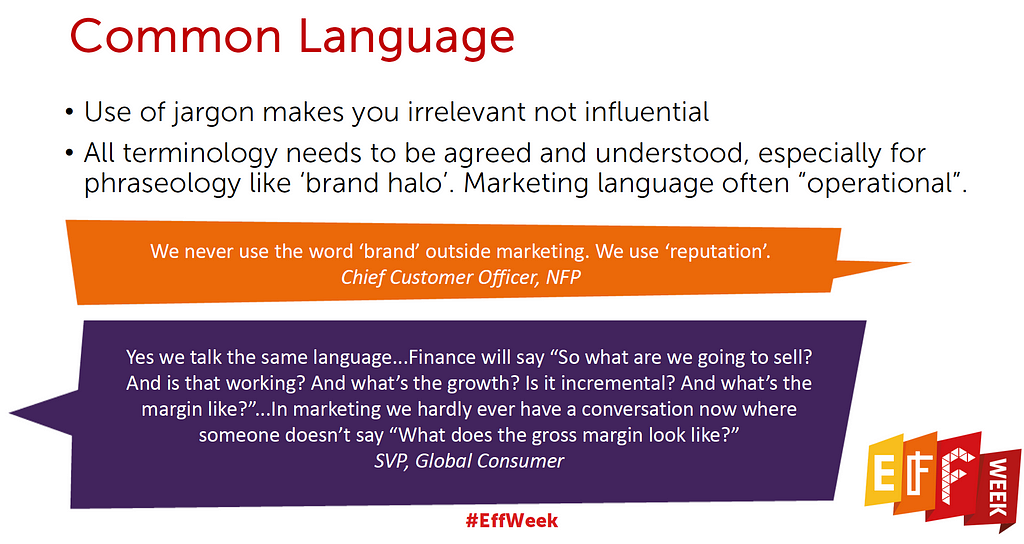 Building Bridges with Finance, Fran Cassidy
Building Bridges with Finance, Fran Cassidy
Marketing needs to become more “grown up”, less siloed away from the CFO and more commercially responsible, but while a CMO survey in August 2018 had marketing leading ‘Brand’ in 91.4% of companies, only 40.1% were leading revenue growth — meanwhile in agency world there is often trouble telling the difference between GAAP and GAFA.
Our language does not reflect boardroom priorities.
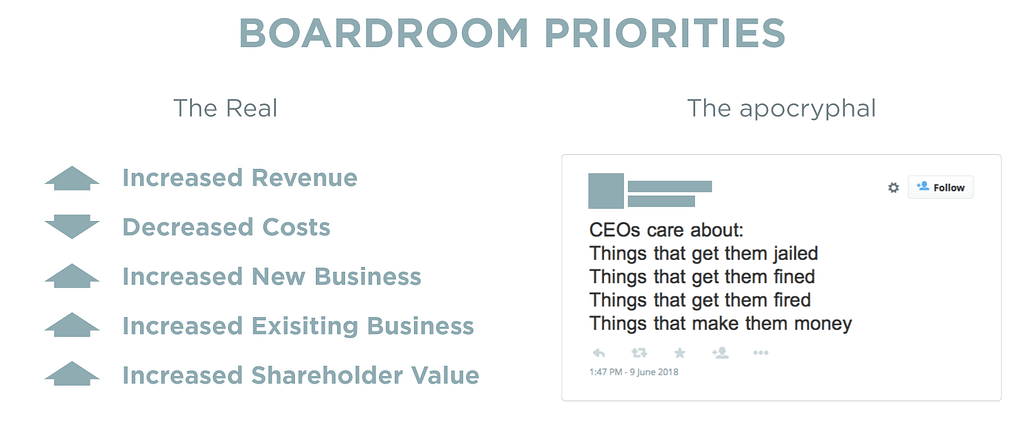 Real priorities (and some “slightly” tongue-in-cheek ones)
Real priorities (and some “slightly” tongue-in-cheek ones)
Nowhere is this language disconnect more clear than in the dreaded e-word: engagement. According to Google Trends the use of the term in a marketing context has doubled since 2009 alongside the rise of social media. Engagement in marketing is very much the language of channels, campaigns and short term activation. It is a proxy signal for people interacting with communications material online through likes, comments, sharing, clicks etc. It signals the hope that the work we make is not echoing in the void (or a <3 second “view”).
You don’t find business and finance talking about “engagement”?
Actual they do, only the language of business has a serious accent.
Consider perhaps a profits warning from ASOS below… Here customer engagement is something very different— active customers, average selling price, average basket size, average basket value, order frequency, conversion.
This does not mean that social engagement, or channel and brand metrics are not useful. They just need to be validated and linked to “real value” and how they drive the kind of customer engagement that a CFO can understand.
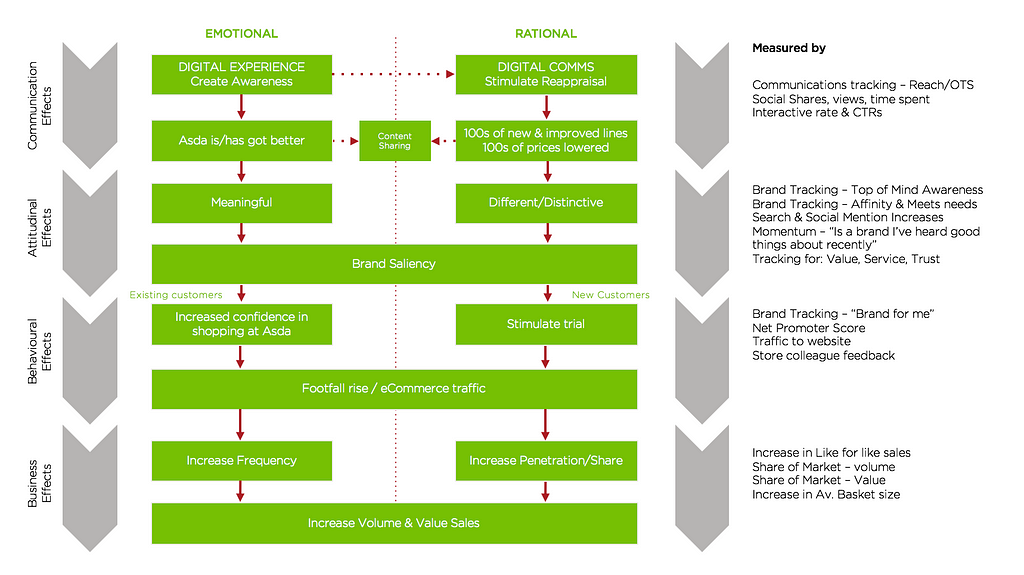 Effect Roadmaping digital and social engagement to Consumer and Business Value
Effect Roadmaping digital and social engagement to Consumer and Business Value
This is the value of focusing on value: it aligns. “Once an organisation — top to bottom — speaks of value in the same terms, many other things fall in line including incentives, prioritisation, and decision-making.”
Using the Marketing Value Wheel we’ve been able to ensure marketing, finance and the C-suite are speaking in the same terms or can see the connection between each party’s priority concepts. It can also help bridge the gap between the desire for short-term, immediate sales activity and the correct strategies to drive long-term revenue and profit growth.
The ultimate purpose of the Marketing Value Wheel as a framework is to make the first step in helping companies develop a shared language that aligns on what we mean by “value” and the effectiveness strategies that flow from it, strategies that can be executed better than one’s competitors with robust, benchmarked measures that prove (or disprove) success. While its Drivers, Strategies and Value Tactics may need to be tailored to individual companies and some categories — indeed we have used a quite different wheel with Service Design projects in Big Pharma — it hopefully can be a simple and useful tool.
But talking about value is nothing without credible evidence for our decisions. It must work in close parallel with marketing measurement rooted in effectiveness before, during and after activity, not a list of KPIs as the last slide of a deck.
That’s quite valuable.
— — — — —
*minus Special Publics/Government & Regulatory which provide permission to operate.
What Value do you Create? Marketing’s 3 Types of Value was originally published in Hacker Noon on Medium, where people are continuing the conversation by highlighting and responding to this story.
Disclaimer
The views and opinions expressed in this article are solely those of the authors and do not reflect the views of Bitcoin Insider. Every investment and trading move involves risk - this is especially true for cryptocurrencies given their volatility. We strongly advise our readers to conduct their own research when making a decision.
